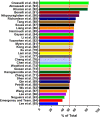Impact of SARS-CoV-2 on Male Reproductive Health: A Review of the Literature on Male Reproductive Involvement in COVID-19
- PMID: 33330557
- PMCID: PMC7711165
- DOI: 10.3389/fmed.2020.594364
Impact of SARS-CoV-2 on Male Reproductive Health: A Review of the Literature on Male Reproductive Involvement in COVID-19
Abstract
Coronavirus Disease 2019 (COVID-19) has created a global pandemic. Global epidemiological results show that elderly men are susceptible to infection of COVID-19. The difference in the number of cases reported by gender increases progressively in favor of male subjects up to the age group ≥60-69 (66.6%) and ≥70-79 (66.1%). Through literature search and analysis, we also found that men are more susceptible to SARS-CoV-2 infection than women. In addition, men with COVID-19 have a higher mortality rate than women. Male represents 73% of deaths in China, 59% in South Korea, and 61.8% in the United States. Severe Acute Respiratory Syndrome Coronavirus 2 (SARS-CoV-2) is the pathogen of COVID-19, which is transmitted through respiratory droplets, direct and indirect contact. Genomic analysis has shown that SARS-CoV-2 is 79% identical to SARS-CoV, and both use angiotensin-converting enzyme 2 (ACE2) as the receptor for invading cells. In addition, Transmembrane serine protease 2 (TMPRSS2) can enhance ACE2-mediated virus entry. However, SARS-CoV-2 has a high affinity with human ACE2, and its consequences are more serious than other coronaviruses. ACE2 acts as a "gate" for viruses to invade cells and is closely related to the clinical manifestations of COVID-19. Studies have found that ACE2 and TMPRSS2 are expressed in the testis and male reproductive tract and are regulated by testosterone. Mature spermatozoon even has all the machinery required to bind SARS-CoV-2, and these considerations raise the possibility that spermatozoa could act as potential vectors of this highly infectious disease. This review summarizes the gender differences in the pathogenesis and clinical manifestations of COVID-19 and proposes the possible mechanism of orchitis caused by SARS-CoV-2 and the potential transmission route of the virus. In the context of the pandemic, these data will improve the understanding of the poor clinical outcomes in male patients with COVID-19 and the design of new strategies to prevent and treat SARS-CoV-2 infection.
Keywords: ACE2; COVID-19; SARS-CoV-2; gender differences; male fertility; tmprss2.
Copyright © 2020 He, Liu, Feng, Xiong, Li, Chen, Li, Wang, Li and Fu.
Figures


Similar articles
-
Age and gender differences in ACE2 and TMPRSS2 expressions in oral epithelial cells.J Transl Med. 2021 Aug 19;19(1):358. doi: 10.1186/s12967-021-03037-4. J Transl Med. 2021. PMID: 34412632 Free PMC article.
-
Effects of acute severe acute respiratory syndrome coronavirus 2 infection on male hormone profile, ACE2 and TMPRSS2 expression, and potential for transmission of severe acute respiratory syndrome coronavirus 2 in semen of Asian men.F S Sci. 2022 Feb;3(1):29-34. doi: 10.1016/j.xfss.2021.11.003. Epub 2021 Nov 20. F S Sci. 2022. PMID: 34841282 Free PMC article.
-
SARS-CoV-2, fertility and assisted reproduction.Hum Reprod Update. 2023 Mar 1;29(2):177-196. doi: 10.1093/humupd/dmac037. Hum Reprod Update. 2023. PMID: 36374645 Free PMC article. Review.
-
Placental Expression of ACE2 and TMPRSS2 in Maternal Severe Acute Respiratory Syndrome Coronavirus 2 Infection: Are Placental Defenses Mediated by Fetal Sex?J Infect Dis. 2021 Dec 8;224(Suppl 6):S647-S659. doi: 10.1093/infdis/jiab335. J Infect Dis. 2021. PMID: 34293137 Free PMC article.
-
Contributions of human ACE2 and TMPRSS2 in determining host-pathogen interaction of COVID-19.J Genet. 2021;100(1):12. doi: 10.1007/s12041-021-01262-w. J Genet. 2021. PMID: 33707363 Free PMC article. Review.
Cited by
-
Impacts of COVID-19 and SARS-CoV-2 on male reproductive function: a systematic review and meta-analysis protocol.BMJ Open. 2022 Jan 5;12(1):e053051. doi: 10.1136/bmjopen-2021-053051. BMJ Open. 2022. PMID: 34987042 Free PMC article.
-
SARS-CoV-2 effect on male infertility and its possible pathophysiological mechanisms.Discoveries (Craiova). 2021 Jun 30;9(2):e131. doi: 10.15190/d.2021.10. eCollection 2021 Apr-Jun. Discoveries (Craiova). 2021. PMID: 34816001 Free PMC article. Review.
-
Long-term consequences of sexually transmitted infections on men's sexual function: A systematic review.Arab J Urol. 2021 Jul 7;19(3):411-418. doi: 10.1080/2090598X.2021.1942414. eCollection 2021. Arab J Urol. 2021. PMID: 34552793 Free PMC article. Review.
-
Sex and ABO Blood Differences in SARS-CoV-2 Infection Susceptibility.Glob Med Genet. 2023 Jan 30;10(1):22-26. doi: 10.1055/s-0043-1761202. eCollection 2023 Jan. Glob Med Genet. 2023. PMID: 36727032 Free PMC article.
-
Implications of RNA Viruses in the Male Reproductive Tract: An Outlook on SARS-CoV-2.Front Microbiol. 2021 Dec 24;12:783963. doi: 10.3389/fmicb.2021.783963. eCollection 2021. Front Microbiol. 2021. PMID: 35003013 Free PMC article. Review.
References
Publication types
LinkOut - more resources
Full Text Sources
Miscellaneous

